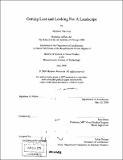| dc.contributor.advisor | Joan Jonas. | en_US |
| dc.contributor.author | Mazzotta, Matthew | en_US |
| dc.contributor.other | Massachusetts Institute of Technology. Dept. of Architecture. | en_US |
| dc.date.accessioned | 2009-11-06T16:25:56Z | |
| dc.date.available | 2009-11-06T16:25:56Z | |
| dc.date.copyright | 2009 | en_US |
| dc.date.issued | 2009 | en_US |
| dc.identifier.uri | http://hdl.handle.net/1721.1/49727 | |
| dc.description | Thesis (S.M.)--Massachusetts Institute of Technology, Dept. of Architecture, 2009. | en_US |
| dc.description | Most text printed 23 x 29 cm. | en_US |
| dc.description | Includes bibliographical references (p. 90-91). | en_US |
| dc.description.abstract | The possibility of becoming lost is always present, as far away as another country or as close as your own body. When truly lost, there is at first, an examining of the unfamiliar, then a quick check-in with what we know. In a way, becoming lost is a way of finding what we know. It seems that when we are off-course, we become hyper-aware of our surroundings, scanning to find out what appears to be going on. We ask, why is this happening in this way, and how is it different from what I know? Leaving the realms of what we know by going to unfamiliar spaces allows us to become more present in our immediate situation. In my work I am searching for ways of inviting this condition. Looking for a Landscape, my final work at MIT, takes as its site an ordinary object from an urban space. The work is about exposing what we do not see in our everyday lives to provide an opening for participation and dialogue through the creation of unfamiliar visions of our environment. Through seeing the city in a different way we can suddenly become lost and find opportunities for discovery. The original housing of Looking for a Landscape is a standard city utility box with a concrete base, painted and graffitied like all of the other utility boxes in the city. The doors are modified so that they do not open like a normal utility box, but are hinged at the bottom and pull down, cantilevering like a drawbridge, to create two large platforms on either side on which to sit. | en_US |
| dc.description.abstract | (cont.) Each of these platforms is upholstered with a gold-trimmed, maroon colored pillow that covers the entire surface. Binoculars, the same kind used for sightseeing at the entire surface. Binoculars, the same kind used for sightseeing at scenic locations, are mounted at eye-level on top of a post at the center of each pillow. These binoculars point out into the city, becoming a viewing station of the everyday. The entire structure is on retractable wheels embedded inside the concrete base. When the wheels are up, the utility box looks like a stationary, permanent part of the city. When the wheels are brought down, by a cranking mechanism inside the base, they make contact with the ground allowing Looking for a Landscape to be moved to the next location of the city. In this thesis, I will discuss Looking For a Landscape as a vehicle for both getting lost and finding direction. I will map out different aspects of "getting lost" through experiences in my life including: intentionally getting lost as a means to finding a new way; understanding the concept of place and social spaces and the grounding relationships we have with them; playing with what is familiar through our senses and the environment around us; and introducing objects and opportunities for opening up social layers within the spaces in which we live. | en_US |
| dc.description.statementofresponsibility | by Matthew Mazzotta. | en_US |
| dc.format.extent | 91 p. | en_US |
| dc.language.iso | eng | en_US |
| dc.publisher | Massachusetts Institute of Technology | en_US |
| dc.rights | M.I.T. theses are protected by
copyright. They may be viewed from this source for any purpose, but
reproduction or distribution in any format is prohibited without written
permission. See provided URL for inquiries about permission. | en_US |
| dc.rights.uri | http://dspace.mit.edu/handle/1721.1/7582 | en_US |
| dc.subject | Architecture. | en_US |
| dc.title | Getting lost and looking for a landscape | en_US |
| dc.type | Thesis | en_US |
| dc.description.degree | S.M. | en_US |
| dc.contributor.department | Massachusetts Institute of Technology. Department of Architecture | |
| dc.identifier.oclc | 441991714 | en_US |
